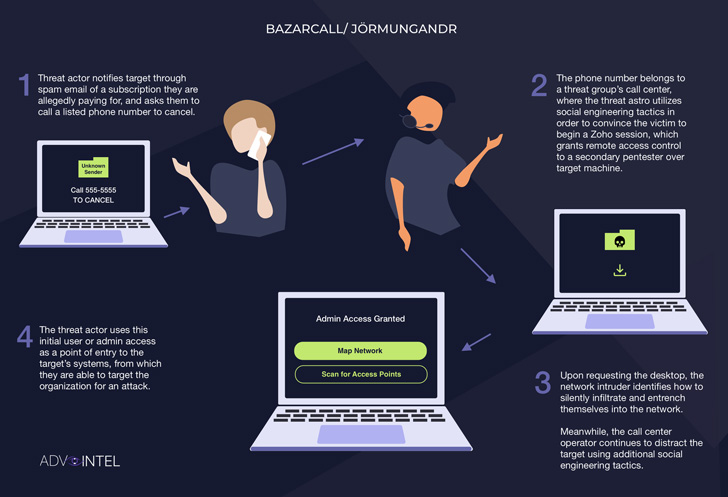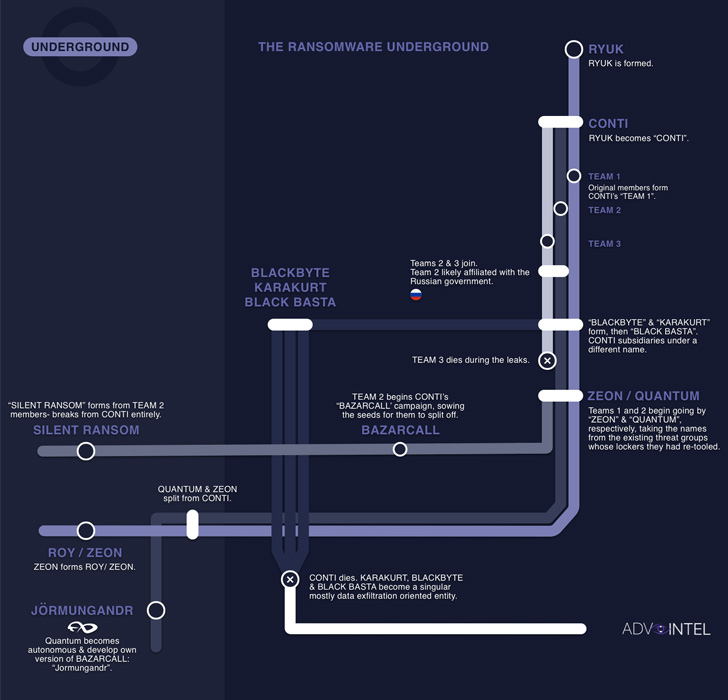Three different offshoots of the notorious Conti cybercrime cartel have resorted to the technique of call-back phishing as an initial access vector to breach targeted networks.
“Three autonomous threat groups have since adopted and independently developed their own targeted phishing tactics derived from the call back phishing methodology,” cybersecurity firm AdvIntel said in a Wednesday report.
These targeted campaigns “substantially increased” attacks against entities in finance, technology, legal, and insurance sectors, the company added.
The actors in question include Silent Ransom, Quantum, and Roy/Zeon, all of which have split from Conti after the latter orchestrated its shutdown in May 2022 following its public support for Russia in the ongoing Russo-Ukrainian conflict.
The advanced social engineering tactic, also called BazaCall (aka BazarCall), came under the spotlight in 2020/2021 when it was put to use by operators of the Ryuk ransomware, which later rebranded to Conti.
It’s said to have received substantial operational improvements in May, around the same time the Conti team was busy coordinating an organization-wide restructuring while simulating the movements of an active group.
The phishing attack is also unique in that it forgoes malicious links or attachments in email messages in favor of phone numbers that recipients are tricked into calling by alerting them of an upcoming charge on their credit card for a premium subscription.
If a target recipient falls for the scheme and decides to call the phone number indicated in the email, a real person from a fraudulent call center set up by BazaCall’s operators attempts to convince the victim to grant the customer service person remote desktop control to help cancel the supposed subscription.
With access to the desktop, the threat actor stealthily takes steps to infiltrate the user’s network as well as establish persistence for follow-on activities such as data exfiltration.
“Call back phishing was the tactic that enabled a widespread shift in the approach to ransomware deployment,” AdvIntel said, adding the “attack vector is intrinsically embedded into the Conti organizational tradition.”
Silent Ransom, the first Conti subgroup to move away from the cybercrime gang in March 2022, has since been linked to data extortion attacks after gaining initial access through subscription expiry emails that claim to notify users of pending payment for Zoho Masterclass and Duolingo services.
“These attacks can be categorized as data breach ransom attacks, in which the main focus of the group is to gain access to sensitive documents and information, and demand payment to withhold publication of the stolen data,” Sygnia noted last month, describing the infection procedure.
The Israeli cybersecurity company is tracking the activities of Silent Ransom under the moniker Luna Moth.
Quantum and Roy/Zeon are the two other Conti spin-offs to follow the same approach starting June 2022. While Quantum has been implicated in the devastating ransomware attacks on the Costa Rican government networks in May, Roy/Zeon consists of members “responsible for the creation of Ryuk itself.”
“As threat actors have realized the potentialities of weaponized social engineering tactics, it is likely that these phishing operations will only continue to become more elaborate, detailed, and difficult to parse from legitimate communications as time goes on,” the researchers said.
The findings come as industrial cybersecurity company Dragos disclosed the number of ransomware attacks on industrial infrastructures decreased from 158 in the first quarter of 2022 to 125 in the second quarter, a drop it attributed with low confidence to Conti closing shop.
That’s not all. Blockchain analytics firm Elliptic revealed this week that the now-defunct Conti group has laundered over $53 million in crypto assets through RenBridge, a cross-chain bridge that allows virtual funds to be transferred between blockchains, between April 2021 and July 2022.




